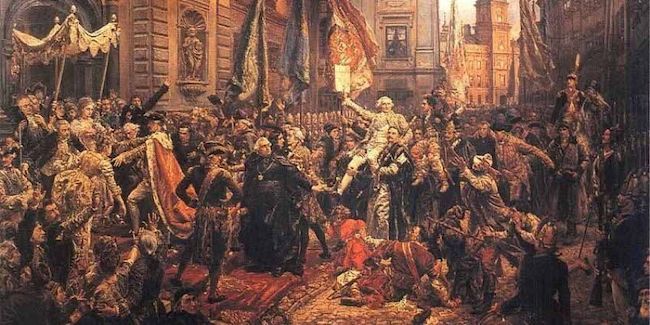The Constitution of May 3 in Poland – the first constitution in Europe and the second in the world
On May 3, Poland celebrates the adoption of the Constitution of May 3.

It is now a public holiday and is one of the three day-by-day holidays that make up the long May weekend in Poland. There is a period when most people at one time go to the long weekend in May, which, depending on how these days fall during the week, after selecting a few days of vacation, it can even extend to 9 days.
What was the May 3rd Constitution?
Its proper name is the Government Act of May 3 – adopted on May 3, 1791, regulating the legal system of the Polish-Lithuanian Commonwealth, which at that time constituted one state and the oldest state union in Europe.
It is commonly assumed that the May 3rd Constitution was the first in Europe and the second in the world (after the American constitution of 1787) written one.
Adopted by King Stanisław August Poniatowski together with the double number of confederated states representing the nation of Poland.
It was designed to eliminate the long-standing shortcomings of the political system of the Polish-Lithuanian Commonwealth based on free election and noble democracy.
The constitution changed the state system into a hereditary monarchy, significantly limited noble democracy by taking away the right to vote and make decisions in matters of the state from nobility without land (golota), introduced partial equalization of personal rights of townspeople and nobility, and placed peasants under the protection of the state, thus mitigating the abuses of serfdom.
The constitution formally abolished the liberum veto.

The adoption of the monarchical Constitution of May 3 caused opposition from the republicans and provoked the hostility of the Russian Empire, which from 1768 was the protector of the Republic and the guarantor of the inviolability of its system. In the war, in defense of the constitution, Poland, betrayed by its Prussian ally Frederick William II, was defeated by the Russian army of Catherine the Great, supporting the Targowica confederation – a conspiracy of some Polish magnates against the change of the Polish political system.
After the loss of independence in 1795, for 123 years of partitions, it reminded us of the struggle for independence. According to two co-authors, Ignacy Potocki and Hugo Kołłątaj, it was “the last will and testament of the dying Motherland”.
The constitution ceased to apply in practice (lost its significance) on July 24, 1792 (when King Stanisław August Poniatowski joined the Targowica Confederation) – that is, after just over 14 months, during which the Four-Year Seym passed a number of detailed laws that developed on its provisions.
However, it ceased to be a legal act (it was derogated) on November 23, 1793. The Grodno Seym then declared the Four-Year Seym null and void and repealed all legal acts enacted therein.
The Constitution of May 3 lasted fourteen months because the laws it introduced to the Republic, demoralized by privileges, were unacceptable to the magnate class. It was they who lost the most, next to the homestead nobility. On the day when the so-called golota, was removed from state power, the magnates, often at the request of Prussian or Russian agents, could not buy by statutes or report liberum veto through the mouths of bribed deputies.
On April 27, 1792, a confederation, later called Targowica, was formed in St. Petersburg. Among them were Szczęsny Potocki, Ksawery Branicki and Seweryn Rzewuski.
At their ‘request‘, a combined force of 20,000 Targovians and 97,000 of the Russian army entered Poland. The king managed to field only an army of 37,000 recruits. Despite several victories in battles, when the Russian army reached Warsaw, the king decided to capitulate and join the Targowica people. The Polish army broke up, and the dream of freedom died for another century.
Concord builds, and discord ruins.
Message from Polish government on the May 3 Constitution:
The May 3 Constitution and the Mutual Pledge of 1791, which tied the Crown and the Duchy of Lithuania even more closely, have a special place in the history of 🇵🇱 and 🇱🇹.
Watch the joint statement of FMs @RauZbigniew and @GLandsbergis marking the 230th anniversary of the events. pic.twitter.com/NggovaJLZ8
— Ministry of Foreign Affairs 🇵🇱 (@PolandMFA) May 3, 2021


